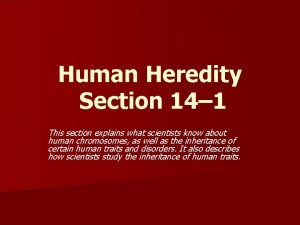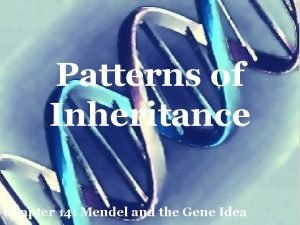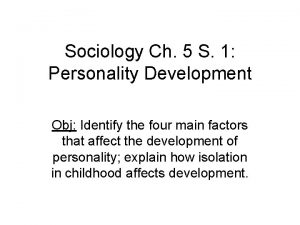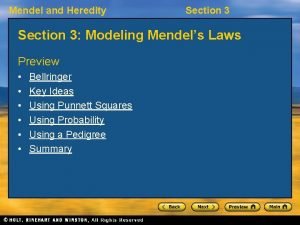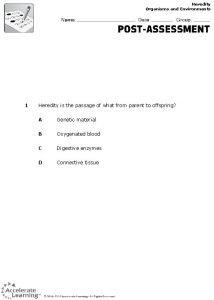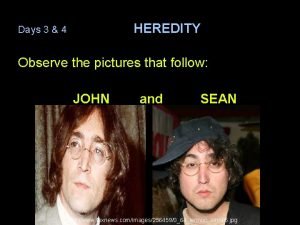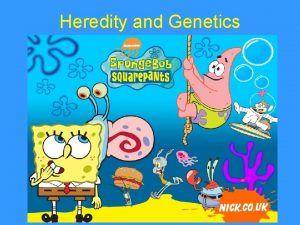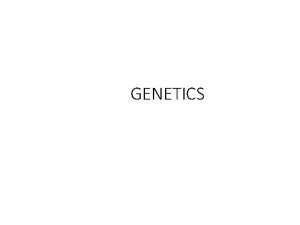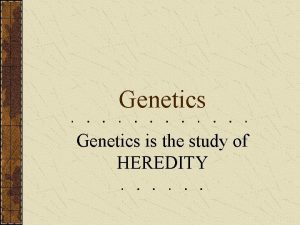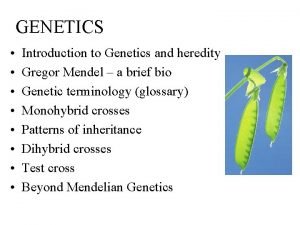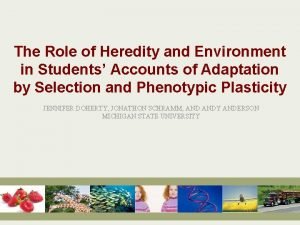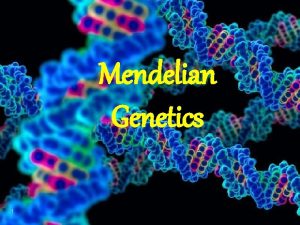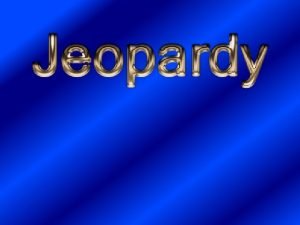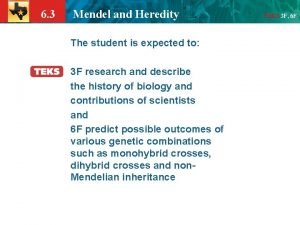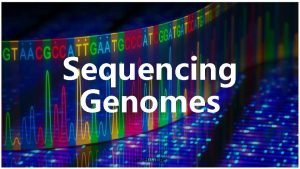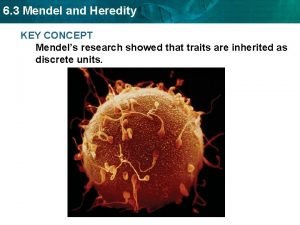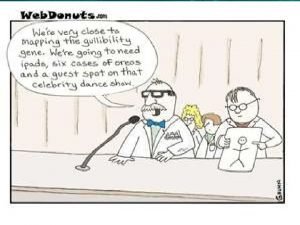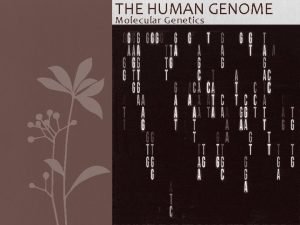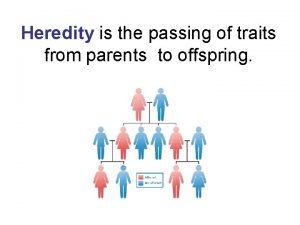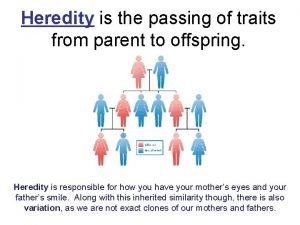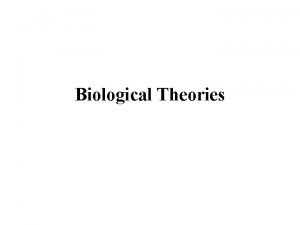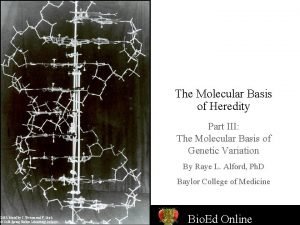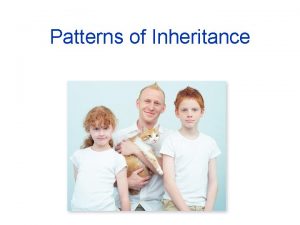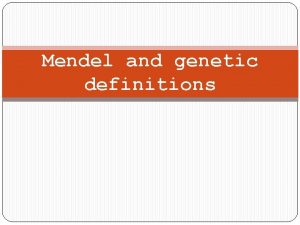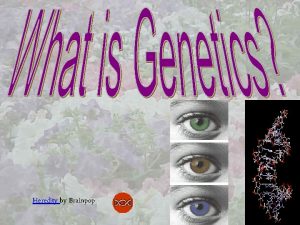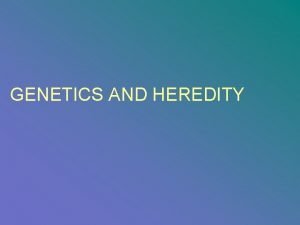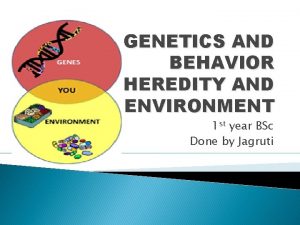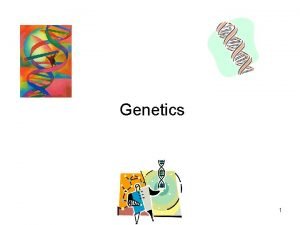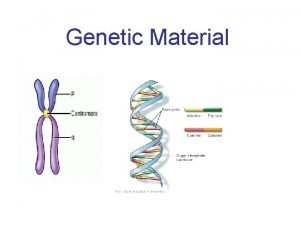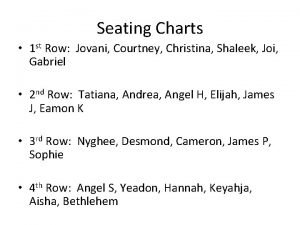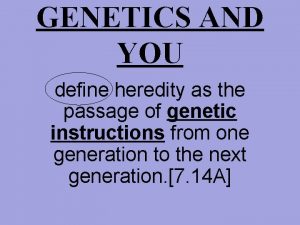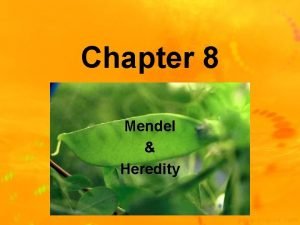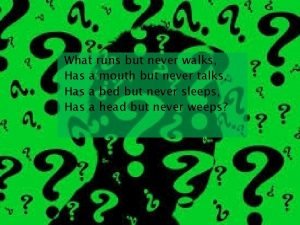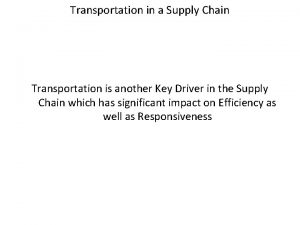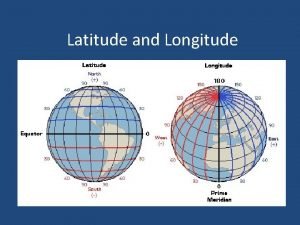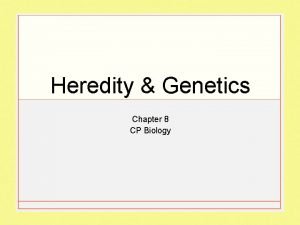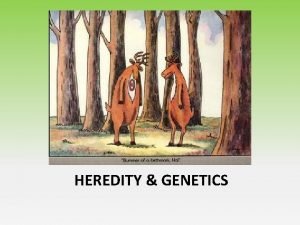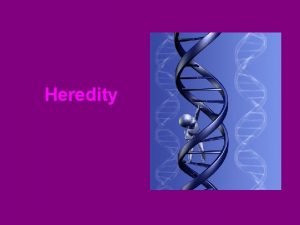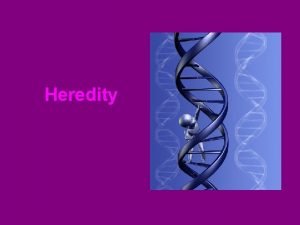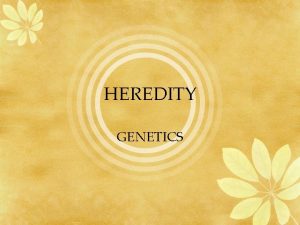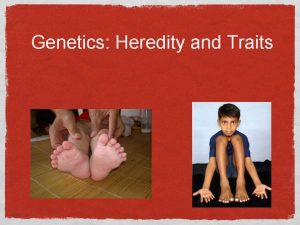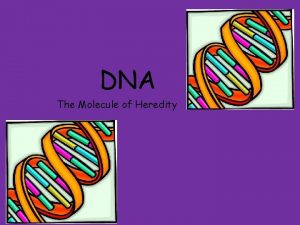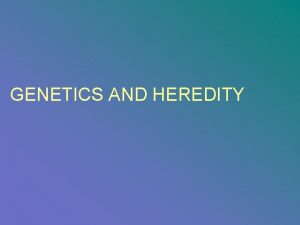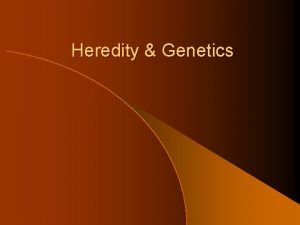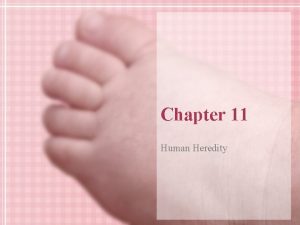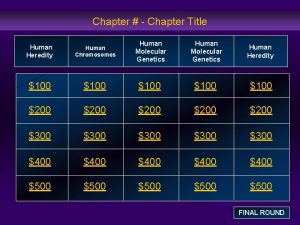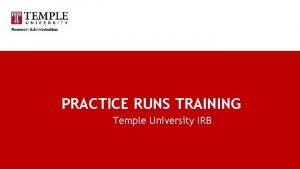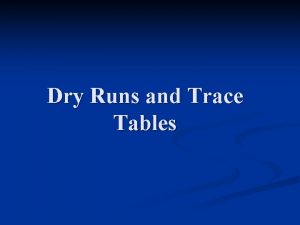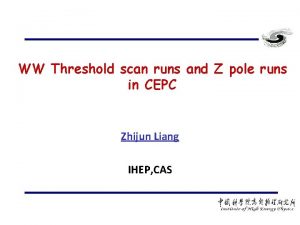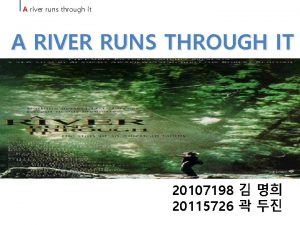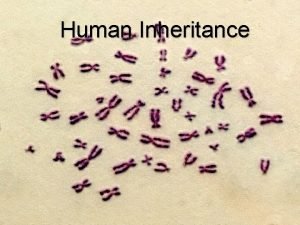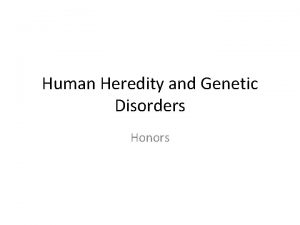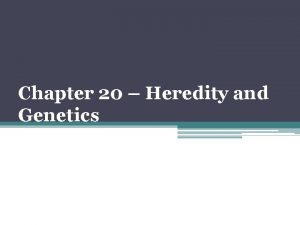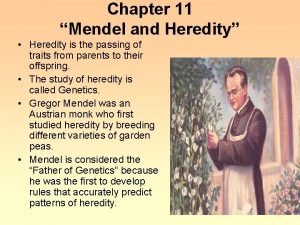Chapter 11 Human Heredity 11 1 It runs



















































- Slides: 51

Chapter 11 Human Heredity

11 -1 “It runs in the family” • Many characteristics of human children are genetically determined • Many human traits are inherited by the action of dominant and recessive allele genes, although other traits are determined through more complicated gene interactions

The Human Organism – A Review • Diploid cell – 2 sets of homologous chromosomes – 46 chromosomes – 23 pairs

• 6 billion nucleotide pairs • 3, 000 letters to a page – over 1 million pages

• Gametes – sperm or egg – Contain a single copy of a gene

• Zygote – fertilized egg – 46 chromosomes – Formed when sperm and egg unite

Human Traits • Phenotype is only partly determined by the genotype • Some traits are strongly influenced by environmental factors (nongenetic) • Examples – exercise and nutrition

• It is important to consider the influence of the environment on the expression of some genes, it must be understood that environmental effects on gene expression are not inherited;

• Genes that are denied a proper environment in which to reach full expression in one generation can, in a proper environment, achieve full potential in a later generation (page 229)

11 -2 The Inheritance of Human Traits • more than 3, 000 human genes have been described

Human Blood Groups • Multiple alleles – genes with more than two forms • Example – ABO and Rh blood groups * Remember – an organism can have two alleles only!

• Blood Type – determined by the presence or absence of certain things in the blood • RBC (Red blood cell) – can carry two different antigens • Antigens – molecules that can be recognized by the immune system

Genotypes and Phenotypes • ii • Type O A A A • I I or I i B B • I I A B • I I or • Type A B I i • Type B • Type AB

Rh Blood Groups • Rh antigen also on RBC + • Rh - have antigen (Dominant) _ • Rh - no antigen (Recessive)

Huntington’s Disease • Caused by a single Dominant allele • Appears in 30’s or 40’s • Progressive loss of muscle control and mental function death • Gene on chromosome 4

Sickle Cell Anemia • Caused by a change in one of the polypeptides found in hemoglobin (carries oxygen in RBC) • One nucleotide difference • Codominant inheritance pattern – A S H H A • H - normal allele S • H – Sickle Cell allele


• Sickle Cell Anemia – common in people of African ancestry and from tropical regions • Carriers (heterozygous) of Sickle A S) Cell trait (H H resistant to malaria

Polygenic Traits • Human traits that are controlled by a number of genes • Example – Height, Body weight, skin color • Phenotypes seen in a range

Example – Skin Color • 4 genes – some may have multiple alleles • Color is determined by the combination of genes • Melanin – dark colored pigment • The darker you are the more genes you have that code for the production of melanin


11 -3 Sex-Linked Inheritance • Genes on an X chromosome are inherited in a sex linked pattern

Nondisjunction • Failure of chromosomes to separate properly during one of the stages of meiosis • Turners Syndrome – 45 X – female • Klinefelters Syndrome – 47 XXY male


Babies are not born without an X 1. X is essential for survival 2. Sex is determined by the presence or absence of Y 3. Y switches on a male pattern of growth

Sex-Linked Genetic Disorders • Gene for the trait is on the X or Y • X has many genes – Y has few • Defects easy to spot – appear more in males

Colorblindness • • Recessive X linked disorder Cannot distinguish colors C Dominant Gene – X c Recessive Gene - X

Carrier • A heterozygous female – has the gene but does not express it – can pass it on to her children

Hemophilia • • Recessive X linked disorder Blood does not clot H X – good gene h X – hemophilia gene

Muscular Dystrophy • Results in the progressive wasting away of muscle

Sex Influenced Traits • A trait that is caused by a gene whose expression differs in males and females

Baldness • A sex influenced trait • Single gene – two alleles

Genotype Male Female BB Normal bb Bald Bb Bald Normal

11 -4 Diagnosis of Genetic Disorders • Down’s Syndrome – Trisomy 21 – Extra copy of the 21 st chromosome • Can be detected by microscopic examinations of chromosomes • karyotype

Parental Diagnosis • Amniocentesis – removes fluid from the sac around the baby – The fluid can be used to grow cells and make a karyotype • Chorionic Villus Biopsy – cells are removed from the embryo – Faster than amnio.

• CVB and Amnio make it possible to detect chromosomal abnormalities • Test for: biochemical abnormalities » Presence of certain DNA sequences

• We can detect over 100 disorders • Knowledge leads to choices and decisions • Ethical Considerations

Genetic Engineering • Biologists can engineer a set of genetic changes directly into an organisms DNA

Restriction Enzymes • Proteins that cut genes at specific DNA sequences

Engineering New Organisms • Transgenic – organisms that contain foreign genes

Transgenic Bacteria • put genes in bacteria and they make things humans need • Ex. Growth hormone

• Curing genetic diseases – 5% of babies in USA born with one • Decoding the human genome (determine the nucleotide sequence of about 3 billion nucleotides or about 100, 000 genes and to map their location on every chromosome) • Personal Id • Diagnosis of disease – 4, 000 human genetic disorders

Genetic Counseling • • • Karyotype DNA Fingerprint CVB Amniocentesis Family History


Pedigrees



• Huntington's disease pedigree

• Which type of inheritance pattern is shown in the above pedigree? • What is individual II-4’s genotype? • How many different genotypes are possible for individual III-2?


 Chapter 11 human heredity section 11-3
Chapter 11 human heredity section 11-3 Chapter 11 complex inheritance and human heredity test
Chapter 11 complex inheritance and human heredity test Chapter 14 human heredity
Chapter 14 human heredity Section 14-1 human heredity
Section 14-1 human heredity Chapter 14 patterns of heredity
Chapter 14 patterns of heredity Chapter 17 lesson 2 heredity and genetics
Chapter 17 lesson 2 heredity and genetics Brainpop heredity worksheet answer key
Brainpop heredity worksheet answer key Heredity characteristics include body build
Heredity characteristics include body build Mendelian genetics concept map
Mendelian genetics concept map Section 3 mendel and heredity
Section 3 mendel and heredity Heredity defines the passage of genetic material from –
Heredity defines the passage of genetic material from – Pictures of heredity
Pictures of heredity Heredity examples
Heredity examples Genetics
Genetics ____________ is the study of heredity.
____________ is the study of heredity. Genotype
Genotype Genes is the study of heredity and variation
Genes is the study of heredity and variation Chromosome
Chromosome Role of heredity
Role of heredity Section 3 mendel and heredity
Section 3 mendel and heredity When do alleles segregate during meiosis
When do alleles segregate during meiosis What are the basic units of heredity
What are the basic units of heredity Mendel 9 3 3 1
Mendel 9 3 3 1 Sanger sequencing
Sanger sequencing Section 3 mendel and heredity
Section 3 mendel and heredity Section 3 mendel and heredity
Section 3 mendel and heredity Heredity
Heredity Flower structure
Flower structure Heredity
Heredity Heredity and crime
Heredity and crime Cpalms heredity tutorial
Cpalms heredity tutorial Molecular basis of heredity
Molecular basis of heredity Early ideas about heredity
Early ideas about heredity Heredity
Heredity Heredity
Heredity Character traits brainpop
Character traits brainpop The scientific study of heredity *
The scientific study of heredity * What is a pheontype
What is a pheontype Zycot
Zycot Heredity acrostic
Heredity acrostic Heredity
Heredity Susie roundpants
Susie roundpants Heredity is the passage of
Heredity is the passage of Heredity
Heredity Chapter 8 human needs and human development
Chapter 8 human needs and human development Chapter 8 human needs and human development
Chapter 8 human needs and human development What runs but never walks
What runs but never walks Milk runs supply chain
Milk runs supply chain A steel beam hangs from a cable
A steel beam hangs from a cable Chemistry dimensions 2 worksheet solutions
Chemistry dimensions 2 worksheet solutions Momentum
Momentum Is latitude horizontal
Is latitude horizontal



